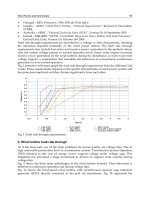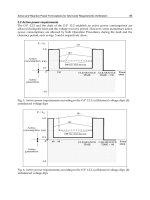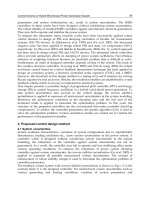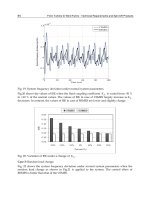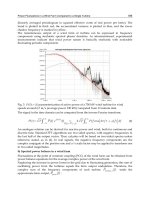From Turbine to Wind Farms Technical Requirements and Spin-Off Products Part 13 docx
Bạn đang xem bản rút gọn của tài liệu. Xem và tải ngay bản đầy đủ của tài liệu tại đây (356.63 KB, 15 trang )
Impact of Intermittent Wind Generation on Power System Small Signal Stability
169
()
s
ssmdr
s
QXI
X
ψ
ψ
=− + (37)
So far, based on the stator flux-oriented control strategy, and considering the decoupled
control of the real and reactive power outputs of DFIG, the whole reduced practical
electromechanical transient DFIG model consists of the following 7
th
order model
0
ds
U
=
(38)
q
st
UU
=
(39)
2
m
t
q
rm
s
X
ds
HUIT
dt X
=
−− (40)
ˆ
dr s s
dr dr
r
r
dI
IU
dt X
T
ωω
=− −
′
′
(41)
2
1
11
11
1
ˆ
() ( )
drref
ms ms t
q
sdr
q
sdr sre
f
ssrs
r
dI
XXU
K
KU I KU U Q
dt X T X X T X
T
ωω
=−+ −+
′
′
(42)
2
22
22
ˆ
1
ˆ
()
dr s s
dr drre
f
dr
r
r
dU
K
KIIKU
dt T T X
T
ωω
=−− −
′
′
(43)
ˆ
qr
ss
q
r
q
r
r
r
dI
IU
dt X
T
ωω
=− −
′
′
(44)
1
11
11
1
ˆ
()
qrref
ms ms
q
s
q
r
q
s
q
r sre
f
ssr
r
dI
XX
K
KU I KU U P
dt X T X X T
T
ωω
=−+ −
′
′
(45)
2
22
22
ˆ
1
ˆ
()
qr
ss
q
r
q
rre
fq
r
r
r
dU
K
KIIKU
dt T T X
T
ωω
=−− −
′
′
(46)
5. Model of wind farm of DFIG type
In this chapter, a simple aggregated model of large wind farm in the small signal stability
analysis is employed. We assume that currently the operating conditions of all wind
generators in a wind farm are same, and the wind farm is considered to be formed with a
number of wind generators jointed in parallel. Therefore, the wind farm can be reduced to a
single machine equivalent. For a wind farm consisted of N wind generators, the values of
stator and rotor voltages are same as the value of single machine. The stator and rotor
currents are N times larger than the single machine. The stator and rotor resistances and
reactances as well as K
2
are 1/N larger than the single machine. The remaining control
parameters are same as the single machine.
From Turbine to Wind Farms - Technical Requirements and Spin-Off Products
170
6. Small signal stability analysis incorporating wind farm of DFIG type
Small signal stability is the ability of the power system to maintain synchronism when
subjected to small disturbances (Kundur, 1994). In this context, a disturbance is considered
to be small if the equations that describe the resulting response of the system may be
linearized for the purpose of analysis. In order to analyze the effects of a disturbance on a
linear system, we can observe its eigenvalues. Although power system is nonlinear system,
it can be linearized around a stable operating point, which can give a close approximation to
the system to be studied.
The behavior of a dynamic autonomous power system can be modelled by a set of n first
order nonlinear ordinary differential equations (ODEs) described as follows (Kundur, 1994)
d
dt
x
=f(x,u)
(47)
0=g(x,u) (48)
where
x is the state vector; u is the vector of inputs to the system; g is a vector of nonlinear
functions relating state and input variables to output variables.
The equilibrium points of system are those points in which all the derivatives
12
, , ,
n
xx x
are simultaneously zero. The system is accordingly at rest since all the variables are constant
and unvarying with time. The equilibrium point must therefore satisfy the following
equation
d
dt
0
00
x
=f(x ,u )=0
(49)
00
0=g(x ,u ) (50)
Where (
x
0
, u
0
) are considered as an equilibrium point, which correspond to a basic operating
condition of power system.
Corresponding to a small deviation around the equilibrium point, i.e.
0
x=x +Δx (51)
0
u=u +Δu (52)
The functions
f(x,u) and g(x,u) can be expressed in terms of Taylor’s series expansion
d
d
dt dt
2
0
00
x
Δx
+=f(x,u)+AΔx+BΔu+O( Δx,Δu)
(53)
2
000
u+Δu=g(x ,u )+CΔx+DΔu+O( Δx,Δu)
(54)
With terms involving second and higher order powers in Eqs(53-54) neglected, we have
Δx=AΔx+BΔu
(55)
0=CΔx+DΔu (56)
Impact of Intermittent Wind Generation on Power System Small Signal Stability
171
Where A, B, C and D are called as Jacobian matrices represented in the following
∂
∂
00
x,u
f(x, u)
A=
x
(57)
∂
=
∂
00
x,u
f(x, u)
B
u
(58)
∂
=
∂
00
x,u
g(x,u)
C
x
(59)
∂
=
∂
00
x,u
g(x,u)
D
u
(60)
If matrix D is nonsingular, finally we have
d
dt
-1
Δx
=(A-BD C)Δx=ΛΔx
(61)
The eigenvalues and eigenvectors of the state matrix can reflect the stability of the system at
the operating point and the characteristics of the oscillation (Kundur, 1994).
According to the established 7
th
order DFIG model described in Section 4, the state variables
are I
dr
, I
drref
, Û
dr
, Û
qr
, I
qr
, I
qrref
and s, respectively, and the algebraic variables are U
ds
, U
qs
, I
ds
, I
qs
,
respectively. In small signal stability analysis, when the wind farm is integrated into the
power grid, these algebraic variables mentioned above in d-q coordinate system need to be
transformed to the synchronous rotating coordinate system (x-y coordinate system), i.e.
these algebraic variables will be subject to
d
q
x
y
=
UUT (62)
d
q
x
y
=
IIΤ (63)
Where
T is transformation matrix,
sin cos
cos sin
θ
θ
θ
θ
−
⎡
⎤
=
⎢
⎥
⎣
⎦
Τ ; θ denotes the phase angle of
generator terminal voltage U
t
, which can be obtained by the steady state power flow
solutions.
Accordingly, we can obtain
x
y
d
dt
Δ
ΔΔ
x
=x+U
WF WF
AB
(64)
x
y
x
y
Δ
=Δ ΔIx+U
WF WF
CD (65)
Where
A
WF
, B
WF
, C
WF
and D
WF
are expressed as follows
From Turbine to Wind Farms - Technical Requirements and Spin-Off Products
172
11
1
2
22
22 2
11
1
2
2
ˆˆ
1
()
1
()
1
()
1
()
dr drref dr qr qrref qr
ss
rr
ms ms
tt
ss
rr
ss
r
ss
rr
ms ms
tt
ss
rr
s
r
IIU I IUs
TX
XX
KU KU
XT X
TX
K
KK
TT T
T
TX
XX
KU KU
XT X
TX
K
T
T
ωω
ωω
ωω
ωω
ωω
ω
ΔΔΔ Δ ΔΔΔ
−−
′′
−
′′
−− − −
′
−−
=
′′
−
′′
−− −
′
WF
A
2
2
22
2
s
m
t
s
K
K
TT
X
U
HX
ω
⎡ ⎤
⎢ ⎥
⎢ ⎥
⎢ ⎥
⎢ ⎥
⎢ ⎥
⎢ ⎥
⎢ ⎥
⎢ ⎥
⎢ ⎥
⎢ ⎥
⎢ ⎥
⎢ ⎥
⎢ ⎥
⎢ ⎥
⎢ ⎥
⎢ ⎥
⎢ ⎥
−
⎢ ⎥
⎢ ⎥
⎢ ⎥
−
⎢ ⎥
⎣ ⎦
(66)
1
11
11
11
1
00
1
ˆ
0() 2
00
00
1
ˆ
0()
00
0
ds qs
ms ms t
dr dr
sss
rr
ms ms
qr qr
ss
rr
m
qr
s
UU
XXKU
KI KU
XT X TX
TX
XX
KI KU
XT X
TX
X
I
X
ωω
ωω
⎡
⎤
⎢
⎥
⎢
⎥
−+ −
⎢
⎥
′′
⎢
⎥
⎢
⎥
⎢
⎥
⎢
⎥
=
⎢
⎥
−+
⎢
⎥
′′
⎢
⎥
⎢
⎥
⎢
⎥
⎢
⎥
−
⎢
⎥
⎣
⎦
WF
BT
(67)
1
00 0 000
0 00 000
s
m
s
m
X
X
X
X
−
⎡
⎤
−
⎢
⎥
⎢
⎥
=
⎢
⎥
−
⎢
⎥
⎣
⎦
WF
CT
(68)
1
1
0
00
s
X
−
⎡
⎤
−
⎢
⎥
=
⎢
⎥
⎢
⎥
⎣
⎦
WF
D
TT
(69)
Here, each generator in a power system to be studied can be represented as the
aforementioned form in accordance with the dynamic model of itself. For a power system
Impact of Intermittent Wind Generation on Power System Small Signal Stability
173
consisting of n generators (including wind farm) with m state variables, by eliminating ΔI
xy
,
we can get the Jacobian matrices of the whole system
A, B, C and D (Wang et al., 2008)as
given in following
[
]
G
mm
×
=AA
(70)
[
]
2
0
G
mN×
=BB
(71)
2
0
G
Nm
×
−
⎡⎤
=
⎢⎥
⎣⎦
C
C
(72)
22
GG G GL
LG LL
NN×
−
⎡⎤
=
⎢⎥
⎣⎦
YDY
D
YY
(73)
Where
mm
×
⎡⎤
⎢⎥
⎢⎥
⎢⎥
=
⎢⎥
⎢⎥
⎢⎥
⎣⎦
%
%
1
WF
G
n
A
A
A
A
(74)
2mn×
⎡⎤
⎢⎥
⎢⎥
⎢⎥
=
⎢⎥
⎢⎥
⎢⎥
⎣⎦
%
%
1
WF
G
n
B
B
B
B
(75)
2nm
×
⎡⎤
⎢⎥
⎢⎥
⎢⎥
=
⎢⎥
⎢⎥
⎢⎥
⎣⎦
%
%
1
WF
G
n
C
C
C
C
(76)
22nn×
⎡⎤
⎢⎥
⎢⎥
⎢⎥
=
⎢⎥
⎢⎥
⎢⎥
⎣⎦
%
%
1
WF
G
n
D
D
D
D
(77)
Where,
Y
GG
and Y
LL
are the self-admittance matrices of generator nodes and non-generator
nodes;
Y
LG
and Y
GL
are the mutual admittance matrices between them.
From Turbine to Wind Farms - Technical Requirements and Spin-Off Products
174
Finally, the corresponding state matrix can be given in following:
=
-1
Λ A-BD C (78)
7. Probabilistic small signal stability analysis with wind farm
7.1 Principle of Monte Carlo simulation
Monte Carlo method is a class of computational algorithms that rely on repeated random
sampling to compute their results. In uncertainty analysis, the relationship between the
dependent variable and independent variable can be described as
=
Zh(X) (79)
where
X = [x
1
, x
2
, … , x
m
] is the vector of the independent variables and Z=[z
1
,z
2
, … ,z
n
] is
the vector of the dependent variable.
h=[h
1
(X), h
2
(X) , …, h
m
(X)] represents the function
relationship between input variable and output variable. In general, if
h is very complex, it
is hard to solve the probability distribution of
Z applying analytic way. In this situation, the
Monte Carlo methods are employed to calculate the discrete frequency distribution which
approximately simulates its probability distribution. The essence of the uncertainty analysis
is to estimate the statistic properties of
Z based on the statistic properties of X and the
function
h (Fishman, 1996). The most important statistic property in uncertainty analysis is
the probability distribution, which is always described by the probability density function
(PDF). Probability density function describes the probability density of a variable at a given
value (Fishman, 1996). Therefore, the main objective of uncertainty analysis is to estimate
the PDF of the dependent variable on the basis of the PDF of independent variable and their
relationship function. Monte Carlo simulation is a repetitive procedure: (1) The random
independent variable
X is generated based on its PDF; (2) According to the relationship
function
h, the vector Z can be calculated; (3) Repeat (1) and (2), the PDF of the dependent
variable
Z can be estimated when the sample size (the number of repetition) is large enough.
The justification of Monte Carlo simulation comes from the following two basic theorems of
statistics: (i) The Weak Law of Large Numbers and (ii) The Central Limit Theorem. Based on
the above two theorems, it can be proved that with increasing of sample size, the PDF of the
dependent variable obtained by Monte Carlo simulation will approach to that of the
population.
7.2 Probabilistic small signal stability incorporating wind farm
The flow chart of the Monte Carlo simulation technique for power system small signal
stability analysis with consideration of wind generation intermittence is given in Fig. 6.
It is well known that the uncertainty of wind generation is due to the uncertainty of wind
speed, so we begin with the probability distribution of the wind speed. Fig. 7 shows a
Weibull distribution function of wind speed with k = 2 and c =10. When a random wind
speed is generated, the mechanical power output extracted from the wind can be calculated
via a king of wind turbine model usually given by functions approximation. If the wind
speed V
m
is less than the cut-in speed V
cut-in
or is larger than the cut-off speed V
cut-off
, the
wind farm will be tripped. If the current wind speed belongs to the speed range from cut-in
to cut-off, the wind farm will be kept connected to the grid in power flow calculation and
small signal stability analysis. The process is repeated until the pre-set sample size N is
Impact of Intermittent Wind Generation on Power System Small Signal Stability
175
reached. Finally, the probabilistic-statistical analysis can be conducted based on the results
from different wind speed conditions mentioned above to reveal the impact of wind
generation intermittence on power system small signal stability.
Fig. 6. Flow chart of Monte Carlo based probabilistic small signal stability analysis
incorporating wind farm
Weibull distribution of wind
speed
Frequency distribution of wind speed
based on MC
Wind turbine model
Frequency distribution of wind farm
power output based on MC
Set sample size N
i =1
Generate random wind speed V
m
V
m
<=V
cut-in
?
or V
m
>=V
cut-off
?
Wind farm tripped
Power flow calculation with
wind farm integrated
Power flow calculation w/o
wind farm integrated
SSS analysis with wind farm
integrated
SSS analysis w/o wind farm
integrated
i<=N?
i =i+1
Probability statistics analysis
N Y
N
Y
From Turbine to Wind Farms - Technical Requirements and Spin-Off Products
176
Fig. 7. Weibull distribution with k = 2 and c = 10
8. Application example
The IEEE New England (10-generator-39-bus) system was employed as benchmark to test
the proposed model and method. The single line diagram of the test system is given in Fig.
8. In this system, the classical generator model is applied to the synchronous generator G2.
The 4
th
order generator model with a simplified 3
rd
order exciter model is applied to the
remaining 9 synchronous generators. It should be noticed that there is no any power system
stabilizer considered in the test system. All simulations were implemented on the
MATLAB
TM
environment.
G10
G8
G1
G2
G4
G5
G3
G7
G6
G9
29
28
26
25
2
37
30
1
39
9
8
7
5
4
6
11
10
31
12
13
14
3
18 17
27
38
32
15
16
20
19
34 33
24
21
22
23
35
36
Fig. 8. Single line diagram of IEEE New England test power system
A wind farm with 200
×2MW DFIGs is integrated into the non-generator buses, i.e. bus1-
bus29. The corresponding parameters of wind turbine and DFIG are given in Table 1.
Wind speed (m/s)
0 5 10 15 20 25 30
0
0.01
0.02
0.03
0.04
0.05
0.06
0.07
0.08
0.09
0.1
Impact of Intermittent Wind Generation on Power System Small Signal Stability
177
According to the procedure given in Fig. 6, the frequency distribution of wind speed by
applying Monte Carlo method to the Weibull probability distribution of wind speed can be
calculated as depicted in Fig. 9. The sample size is set to be 8000 during simulation.
Parameters Values
ρ
1.2235 kg/m
3
R
45 m
C
p
0.473
V
cut-in
3m/s
V
cut-off
25m/s
V
rated
10.28m/s
R
s
0.00488
X
ls
0.09241
X
lr
0.09955
X
m
3.95279
R
r
0.00549
H
3.5
K
1
0.1406
T
1
0.0133
K
2
0.5491
T
2
0.0096
Table 1. Parameters of wind turbine and DFIG with 2 MW capacity
Fig. 9. Frequency distribution of wind speed
Next, in accordance Eq. (1) and the frequency distribution of wind speed as shown in Fig.9,
for the wind farm with 200*2MW capacity, the probability distribution of wind farm power
output can be finally obtained as shown in Fig. 10. From Fig.10, there exist two
0 5
10 15 20 25 30
0
100
200
300
400
500
600
700
800
Frequency
Wind speed / m/s
From Turbine to Wind Farms - Technical Requirements and Spin-Off Products
178
concentrations of probability masses in the distribution: one corresponds to the value of
zero, in which the wind farm is cut off; the other corresponds to the value of 400MW, in
which the rated power output is generated by the wind farm.
Fig. 10. Probability distribution of wind farm power output
Fig. 11 shows the frequency distribution of the real part of eigenvalues when the wind farm
is connected to bus20.
Fig. 11. Probability distribution of real part of eigenvalues with wind farm integration into
bus20
0 100 200 300 400
500
1000
1500
2000
2500
3000
Wind farm power output (MW)
Frequency
500
1000
1500
2000
2500
3000
Real part value
Frequency
Small signal stable regio
n
0052
0
0
0.
-0.01 -0.03 -0 .02
Impact of Intermittent Wind Generation on Power System Small Signal Stability
179
According to the statistical analysis based on Fig. 11, we found that there is a probability of
roughly 39.1% (3128 out of 8000 in simulation) that the real part of the eigenvalue will be
positive, in which situation the system is small signal unstable. Therefore we can conclude
that the stability probability of the test system is 60.9% in current operating condition.
Furthermore, there exist two concentrations of probability masses in the distribution: the left
one corresponds to the situation that the wind farm is cut off; the right one corresponds to
situation that wind turbine generates rated power.
Under the same wind speed condition, the wind farm is connected to the bus1-29,
respectively. The corresponding results are given in Table 2.
Bus No. of wind generator Stable Probability
20 200 60.9%
Others 200 100%
Table 2. Small signal stable probability with different wind farm integration position
Electro-mechanical oscillation mode can be picked out according to the electro-mechanical
relative coefficient or the frequency of oscillation, i.e. ρ>1 or 0.1<f<2.5Hz (Wang et al., 2008).
The mean and standard error of the mode properties: frequencies, Electro-mechanical
relevant ratio, damping ratio, and the participating factors are given in Table 3. We found
that the 9
th
EM oscillation mode is unstable with a probability of 39.1%, and it is actually the
pair of eigenvalue that determines the small signal stability probability of the whole system.
In summary, according to the simulation results discussed above, we can conclude that the
deterministic small signal stability analysis can be considered as a special case study in the
probabilistic small signal stability analysis. Especially, the probabilistic small signal stability
based on the Monte Carlo method can evaluate the test power system more objectively and
accurately.
9. Conclusion
This chapter addresses the impact of intermittent wind generation on power system small
signal stability. Firstly, the well-known Weibull probability distribution is employed to
reveal wind speed uncertainty. According to the Weibull distribution of wind speed, the
Monte Carlo simulation technique based probabilistic small signal stability analysis is
applied to solve the probability distributions of wind farm power output and the
eigenvalues of the state matrix. Finally, the IEEE New England test power system is studies
as benchmark to demonstrate the effectiveness and validity of the propose model and
method. Based on the numerical simulation results, we can determine the instability
probability of the power system with the uncertainty and randomness of wind power
consideration. And from viewpoint of small signal stability, the most suitable integration
position for wind farm can be determined as well.
From Turbine to Wind Farms - Technical Requirements and Spin-Off Products
180
Frequency Damping ratio EM relevant ratio
EM
mode
Mean Std Mean Std Mean Std
Most
relevant
generator
Stability
1 1.5021 0.0000 0.0506 0.0002 22.9116 0.1119 G8 100%
2 1.4816 0.0003 0.0613 0.0002 36.1465 3.9023 G7 100%
3 1.4569 0.0006 0.0642 0.0010 10.2773 0.3156 G4 100%
4 1.2794 0.0001 0.0363 0.0005 29.5096 0.2265 G8 100%
5 1.2642 0.0013 0.0133 0.0026 91.3249 25.3277 G2 100%
6 1.1370 0.0024 0.0375 0.0001 32.0537 0.0459 G6 100%
7 1.0394 0.0040 0.0084 0.0027 35.6480 1.9408 G9 100%
8 0.9817 0.0012 0.0066 0.0019 48.0187 8.0547 G6 100%
9 0.6554 0.0020 0.0030 0.0033 52.8691 4.1706 G10 60.9%
Table 3. Properties of EM oscillation modes with wind farm integration into bus20
10. References
Ackermann, T. (2005). Wind Power in Power Systems, Wiley, ISBN 0-470-85508-8,
Chichester
Akhmatov, V. (2002). Variable-speed wind turbine with doubly-fed induction generators
part i: modelling in dynamic simulation tools. Wind Engineering, Vol. 26, No. 2, 85-
108, ISSN 0309-524X
de Alegría, IM.; Andreu, J.; Martín, JL.; Ibañez, P.; Villate, JL. & Camblong, H. (2007).
Connection requirements for wind farms: A survey on technical requierements and
regulation, Renewable and Sustainable Energy Reviews, Vol.11, No.8, 1858 – 1872, ISSN
1364-0321
Feijóo, A.; Cidrás, J. & Carrillo, C. (2000). A third order model for the doubly-fed
induction machine, Electric Power Systems Research, Vol.56, No. 2, 121-127, ISSN
0378-7796
Fishman, G. (1996). Monte Carlo: Concepts, Algorithms, and Applications, Springer-Verlag,
ISBN 978-0387-9452-79, New York
Joselin, H. G.; Iniyan, S.; Sreevalsan, E. & Rajapandian, S. (2007). A review of wind energy
technologies, Renewable and Sustainable Energy Reviews, Vol.11, No.6, 1117–1145,
ISSN 1364-0321
Kundur, P. (1994). Power System Stability and Control, McGraw-Hill, ISBN 7-5083-0817-4,
New York
Impact of Intermittent Wind Generation on Power System Small Signal Stability
181
Mei, F. & Pal, B. C. (2005). Modelling and small-signal analysis of a grid connected
doubly-fed induction generator, IEEE Power Engineering Society General Meeting,
pp. 2101–2108, ISBN 0-7803-9157-8, San Francisco, June 2005, IEEE,
New Jersey
Mendonca, A. & Lopes, J. A. P. (2005). Impact of large scale wind power integration on small
signal stability, Future Power System International Conference, pp. 1-5, ISBN 90-78205-
02-4, Amsterdam, Nov. 2005, IEEE, New Jersey
Rouco, L. & Zamora, J. L. (2006). Dynamic patterns and model order reduction in small-
signal models of doubly fed induction generators for wind power applications,
IEEE Power Engineering Society General Meeting, pp. 1–8, ISBN 1-4244-0493-2,
Montreal, July 2006, IEEE, New Jersey
Rueda, J. L.; Colome, G. D. & Erlich, I. (2009). Assessment and enhancement of small signal
stability considering uncertainties. IEEE transaction on Power Systems, Vol. 24, No. 1,
198-207, ISSN 0885-8950
Slootweg, J. G.; Polinder, H.; & Kling, W. L. (2001). Dynamic modelling of a wind
turbine with doubly fed induction generator, IEEE Power Engineering Society
Summer Meeting, pp. 644–649, ISBN 0-7803-7173-9, Vancouver, July 2001, IEEE, New
Jersey
Tapia, G.; Tapia, A. & Ostolaza, J. X. (2006). Two alternative modeling approaches for the
evaluation of wind farm active and reactive power performances. IEEE Transaction
on Energy Conversion, Vol. 21, No. 4, 909 – 920, ISSN 0885-8969
Tapia, A.; Tapia, G. & Ostolaza, J. X. & Saenz, J. X. (2003). Modeling and control of a wind
turbine driven doubly fed induction generator. IEEE Transaction on Energy
Conversion, Vol. 12, No. 2, 194 – 204, ISSN 0885-8969
Tsourakisa, G.; Nomikosb, B. M. & Vournasa, C. D. (2009). Effect of wind parks with doubly
fed asynchronous generators on small-signal stability, Electric Power Systems
Research, Vol.79, No.1, 190–200, ISSN 0378-7796
Wang, C.; Shi, L.; Wang, L. & Ni, Y. (2008). Modelling analysis in power system small signal
stability with grid-connected wind farms of DFIG Type, Wind Engineering, Vol.32,
No.3, 243–264, ISSN 0309-524X
Wang, K. W.; Chung, C. Y.; Tse, C. T. & Tsang K. M. (2001). Probabilistic eigenvalue
sensitivity indices for robust PSS site selection. IEE Proceedings- Generation,
Transmission and Distribution, Vol. 148, No. 4, 603-609, ISSN 1350-2360
Wang, K. W.; Chung, C. Y.; Tse, C. T. & Tsang, K. M. (2000). Improved probabilistic method
for power system dynamic stability studies, IEE Proceedings- Generation,
Transmission and Distribution, Vol.147, No.1, 37-43, ISSN 1350-2360
Wang, X. F.; Song Y. H. & Irving, M. (2008). Modern Power System Analysis, Springer, ISBN
13-9780-3877-2852-0, New York
Wu, F.; Zhang, X. P.; Godfrey, K. & Ju, P. (2006). Modeling and control of wind turbine
with doubly fed induction generator, IEEE Power Systems Conference and
Exposition, pp. 1404–1409, ISBN 1-4244-0177-1, Atlanta, Nov. 2006, IEEE, New
Jersey
From Turbine to Wind Farms - Technical Requirements and Spin-Off Products
182
Xu, Z.; Dong, Z. Y. & Zhang, P. (2005). Probabilistic small signal analysis using Monte Carlo
simulation, IEEE Power Engineering Society General Meeting, pp. 1658–1664, ISBN 0-
7803-9157-8, San Francisco, June 2005, IEEE, New Jersey
Part 5
Spin-off Products of Offshore Wind Farms



